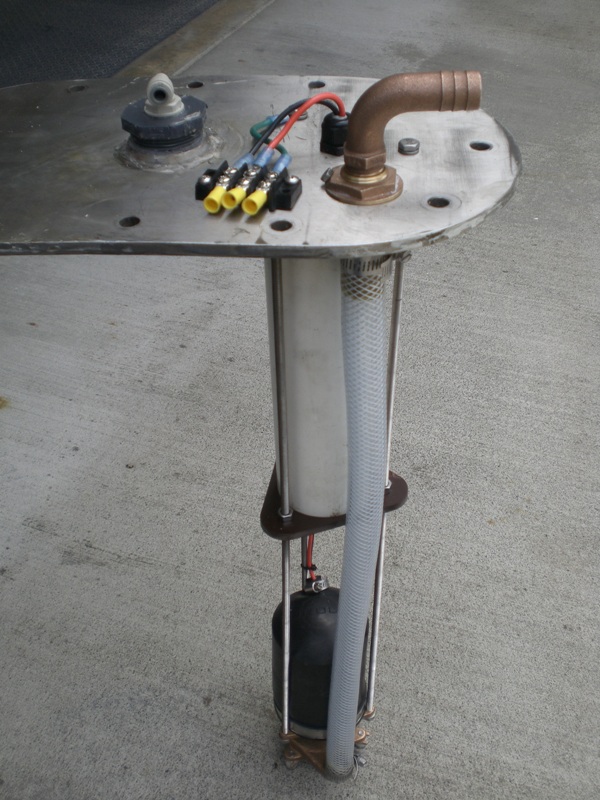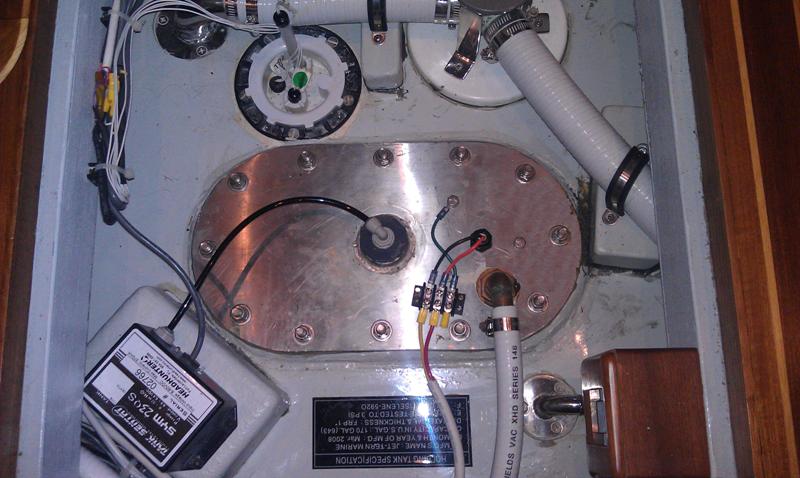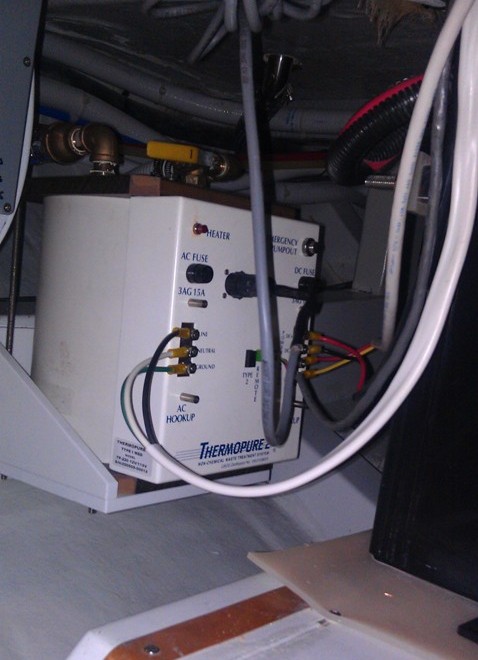


 |
 |
 |
|||
|
|
|||||
| Installing a Thermopure MSD on a Selene 60 | ||||
|
By: Mark Tilden We've had a Thermopure MSD (Marine Sanitation Device) on both our Selene 50 and now our Selene 60. We love the convenience of never having to find a pump out station. Several people have asked us about our installation, so I thought it might be worth creating an article about our installation. Who wouldn't want to sit in a quiet fall evening and read about sewage?
The Thermopure is a USCG certified "Type 1" Waste Treatment System, which means that treated sewage can be legally dumped overboard in most US waters except for designated "no discharge" zones. The Thermopure processes waste by grinding it and heating it to a temperature that kills the harmful bacteria. It can process about 5-3/4 gallons of waste per hour and uses about 1500 watts of AC power while it's running (plus a bit of DC power to run the macerator pump for a few seconds roughly every 3 minutes). Versions of the system are available for 110V and 220V AC power and 12V or 24V DC power. The power requirements are significant, so you probably won't want to run the Thermopure except when you're running your generator, or when you're connected to shore power. The good news is that there are no chemicals involved, and maintenance is minimal.
 We drilled holes in one of the stainless steel inspection covers on the holding tank and hung the Groco macerator from the cover. The rods and other mounting hardware were provided by Groco based on measurements I supplied for the depth of the tank.
We drilled holes in one of the stainless steel inspection covers on the holding tank and hung the Groco macerator from the cover. The rods and other mounting hardware were provided by Groco based on measurements I supplied for the depth of the tank.Groco sells the Thermopure in two versions. The first version comes complete with a secondary holding tank, a macerator pump installed in the secondary tank, and the "cooker" unit (which they call the "treatment module"). This is the version we had on our Selene 50. We had the secondary tank installed in a locker that was behind the toilet in the master head. The cooker unit was installed in the bilge. This installation has the advantage of increasing your total holding tank capacity. The secondary holding tank is available in 10, 15, 20, and 30 gallon sizes. The down-side of this type of installation is added complexity. You have to install a transfer pump of some kind between the primary holding tank and the secondary tank. The Thermopure can be setup to operate this transfer pump automatically whenever there is at least 10% in the main holding tank and when the secondary holding tank is no more than 75% full. However, if the secondary holding tank capacity is smaller than the primary tank, there is a risk of overflowing the secondary tank if the level sensor in the secondary tank fails and doesn't shut off the transfer pump. That was a constant worry on our Selene 50, so when we installed the system on our Selene 60, we opted for the "retrofit" version. In the retrofit version, you purchase only the Groco macerator pump and the cooker unit (plus some accessories). In this installation, you install the Groco macerator in your primary holding tank and plumb the output of that macerator directly to the cooker unit. The primary advantage of this installation is simplicity. There's no transfer pump and no chance of overflowing a secondary tank. The challenge with this type of installation is that installing Groco's macerator--which is a submersible pump that hangs inside the holding tank can be challenging, especially in the smaller Selene where the holding tank is shallow and shaped like the bottom of the hull. Our Selene 60 has a rectangular holding tank so the pump installation was easier. By the way, when we were preparing for our installation, I asked Groco if we could use a different (external) macerator with the system. They said that doing so would both void the warranty on the cooker and would make the USCG certification invalid. I suppose that could result in failing an inspection by the Coast Guard. My biggest concern was Groco's willingness to cover and problems with the cooker if I used a different macerator. The important first step is figuring out where you're going to mount the components, including the secondary tank if you use one, or the macerator pump if you use the retrofit version. The cooker is less than 12" on a side and can be mounted in a variety of orientations, so it's usually not too hard to find a spot for it. The macerator pump makes a little bit of noise for a few seconds when it runs roughly every 3 minutes, but even that noise is minimal. The cooker is completely silent. You'll also need to install a dedicated 3/4" discharge thru-hull. The discharged waste does come out pretty hot, so be careful that the hose you use can handle the temperature.
 The completed macerator assembly installed in the tank. The small black box in the lower left is the Tank Sentry air compressor that is part of the level sensing system. Jet Tern also installed the standard Tank Watch system, but it's really not necessary with the Tank Sentry system.
The completed macerator assembly installed in the tank. The small black box in the lower left is the Tank Sentry air compressor that is part of the level sensing system. Jet Tern also installed the standard Tank Watch system, but it's really not necessary with the Tank Sentry system.In our case, we mounted the macerator in the main holding tank and mounted the cooker in the bilge on a starboard plastic shelf. See the photos. Mounting the macerator took some planning. The macerator comes mounted to a phenolic plate that's about 8" square. Groco's intent is for you to cut a hole in the top of the tank just a little smaller than the phenolic plate, and mount the plate, with the macerator hung from it, in the top of the tank. Using the plate would have required cutting a fairly large hole in the top of our holding tank, and there wasn't really that much accessible room on the top of the tank anyway. So, I elected to drill matching holes in one of the two large stainless inspection port covers on the top of the tank using the phenolic plate as a template. I hung the entire macerator assembly from the stainless plate. It looked more secure to me that Groco's plate anyway. I'd already specified the depth of the tank for Groco and they supplied mounting rods and hoses that were the appropriate length for hanging the macerator near the bottom of the tank. The retrofit kit also comes with a floating level sensor, but my boat has a Headhunter "Tank Sentry" system which includes a programmable relay that can be used to turn pumps (or the Thermopure) on and off, so we didn't need a separate level sensor. The Tank Sentry is very reliable because it measures tank levels by pumping air into a dip tube that extends near the bottom of the tank. It measures the air pressure in the tube, which is proportional to the level in the tanks. There are no floats to stick or clean.
 The "cooker" (Groco calls it the "treatment module") is mounted on a starboard (HDPE) shelf in the bilge of our Selene 60
The "cooker" (Groco calls it the "treatment module") is mounted on a starboard (HDPE) shelf in the bilge of our Selene 60You have to run both AC and DC power to the cooker unit, and then a DC power line goes from the cooker to the macerator pump in the holding tank. The cooker unit contains the electronics that control the process, including the macerator. We elected a 24V DC and 115V AC unit. The boat's DC system is all 24V and I wanted the flexibility to run the Thermopure on one of our 2 4KW Mastervolt inverters if we wanted to, so the 115V AC unit was a good choice for our installation. Maintenance is minimal. Groco recommends you flush the cooker unit weekly by filling the holding tank to 75% with fresh water and letting the system process the tank contents normally. In our case, with a 170 gallon holding tank, it would take the system nearly 24 hours to process that much fresh water, so we usually don't fill it anywhere near that full (and I honestly don't flush it more than a couple times/year). There is also a flush valve on the top of the cooker that you can attach a garden hose to and flush the unit that way. I'm considering installing a permanent connection to our water system (with a check valve and shut off valve) to make flushing easier. [Update: I've since done this. It's a great addition to the system!] If you use Groco's floating level sensor, they also want you to remove and clean monthly. Since we didn't use Groco's level sensor, that isn't an issue for us. We had one infant mortality problem with the cooker unit that Groco handled under warranty. Other than that, we've had no issues and we're very pleased with the system. One of the accessories that comes with the system is called the "Sweet Tank" that's basically just a small air pump like an aquarium aerator pump. This Sweet Tank system is supposed to inhibit the growth of anaerobic bacteria that causes the odor issues by pumping a constant small stream of air through a hose with holes in it on the bottom of the tank. We didn't find the system to be particularly effective in our Selene 50 (it may work on the tank, but you still have any odor issues with all the rest of the plumbing), so we didn't install it in our Selene 60. We had some odor issues initially because the vented loops weren't properly vented overboard. Correcting that seems to have solved the odor issues. By the way, just in case you were wondering, I have no connection whatsoever to Groco. I'm just a satisfied customer.
Links to the various manufacturer's web sites are listed here:
|
||||
 
| ||||
| Copyright (c) MDT Consulting, LLC 2007. All rights reserved. | Visit the Selene manufacturer's web site | Use & Privacy Policy | Contact us | |